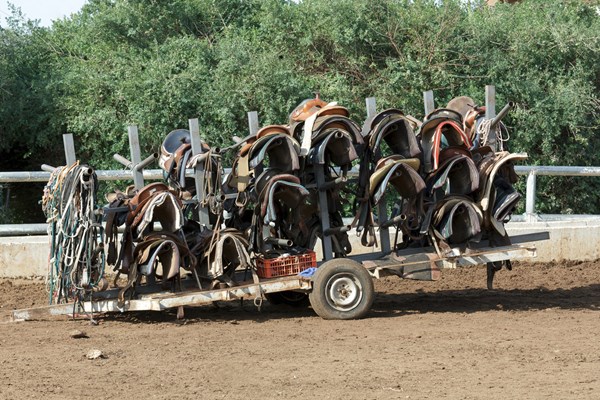 Credit: Thinkstock Properly cleaning all your tack–especially the parts that come in contact with the horse–can seem like a daunting task. But it needs to be done regularly not only to extend the life of the saddle, but to prevent cracking and breaking of important leather parts.
Credit: Thinkstock Properly cleaning all your tack–especially the parts that come in contact with the horse–can seem like a daunting task. But it needs to be done regularly not only to extend the life of the saddle, but to prevent cracking and breaking of important leather parts.Proper saddle care is important to keep the leather in good repair and extend the life of the saddle.Cary Schwarz, saddle maker in Salmon, Idaho, has several tips for cleaning a saddle.
“Leather is a natural fiber, and it is subject to damage from moisture and bacteria,” said Schwarz. “If it’s not cared for properly, it tends to break down. Leather does better in a dry climate than a wet one, regarding moisture and mildew, but make sure you keep some oil content in the leather.”
It’s always wise to clean a saddle before you oil it.“Dirt, in my view, is more destructive than other factors,” added Schwarz. “People get in the habit of just putting some oil over a saddle without cleaning it first, and that tends to fix the dirt onto te leather; it cakes on and is there to stay.So you are oiling over the top of dirt, and addressing only a fraction of the problem.”
What that means to you is that the dirt combines with the oil and adheres to the leather, making it even harder to get off, especially if it’s a stamped saddle. But it can adhere to a smooth surface, too,” noted Schwarz. “So a thorough cleaning should be the first order of business.”
Cleaning a saddle will also get rid of the sweat.Any piece that comes into contact with the horse (anything below the bottom line of the skirt–fenders, billets, back cinch, stirrup leathers, etc.) should be thoroughly washed, especially on the underside.Warm moisture from the horse carries with it all the salts from his sweat and dirt from his body.“The lower half of the fender can become very brittle with years of neglect and not being washed,” noted Schwarz, reminding horse owners that salt is very hard on leather.
“After you’ve washed the saddle and it has been allowed to dry, go over the leather with a conditioner, oil, or whatever you wish to use,” he said. “If the leather seems really dry, use a high grade of oil to replace what time and washing have removed.The oil should be used sparingly, unless leather is quite dry.Over-oiling will add unnecessary weight to the saddle and it may also ‘bleed out’ of the leather in hot weather.”
The whole saddle should be periodically cleaned and conditioned.“The latigo is often looked at less than other parts, because it is always in contact with the horse,” said Jeff Minor, a saddle maker at Baker, IdahoYet it needs attention to make sure it doesn’t get hard, brittle or cracked, which will make it weaker. With that weakness comes the risk of breaking and having the saddle part company with the horse.
If you are riding the same horse (or the same size horses) all the time, you are always buckling the cinch or girth in the same place.“The leather gets a permanent bend in it, and after while if you happen to change the location of the buckle, there is no lubrication to allow the leather to relax and go back to proper shape without cracking or breaking some of the fibers,” said Minor.
The latigo and inside of the fenders on a saddle are what get the most abuse from horse sweat.“The sweat penetrates the leather and eventually works clear through,” said Minor. “Once the sweat gets to the outside, the leather becomes hard and brittle, and it’s too late to salvage it.This is one reason to go through your whole saddle at least once or even twice a year, to clean it.”
If you don’t ride much in winter, one cleaning should take place after your last ride in the fall.“Always clean the saddle after most of your riding is done, and oil it,” said Minor. “If you want to use some kind of leather dressing, this is a good time to do it.Then in the spring, it’s ready to go.It’s also good to periodically clean it during summer, especially if it’s gotten wet or muddy.The horse may sweat a lot during first rides in the spring before he gets back into shape, and sweat should be cleaned off the saddle.”



